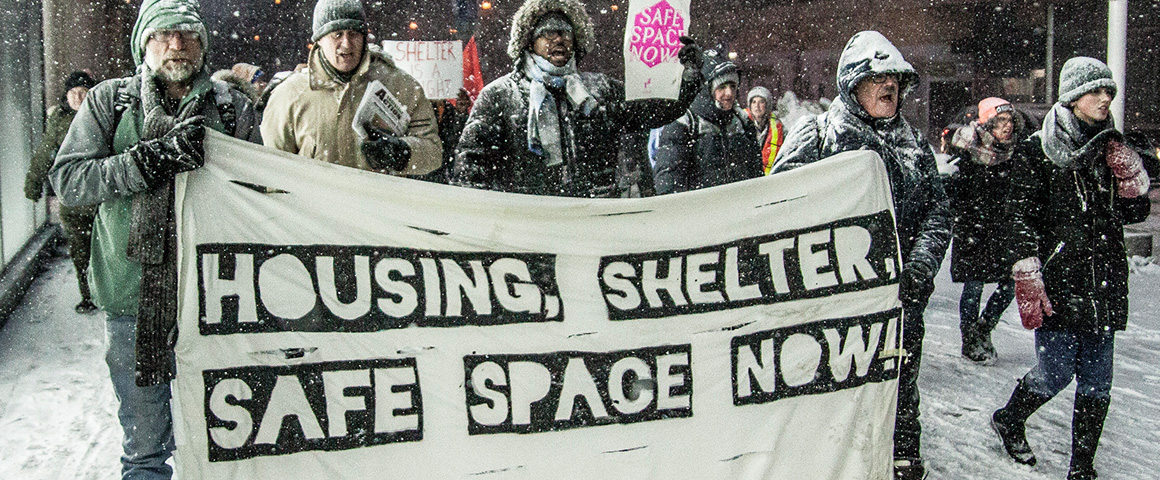October 17 is the International Day for the Eradication of Poverty. Despite claims that economic progress has lifted huge number of people world-wide above the poverty line, the World Bank estimated that in 2015, 705 million people were living on $1.90US per day or less.
Here in Canada, nearly five million people – one out of every seven individuals – currently live in poverty. Vulnerable groups such as people living with disabilities, single parents, elderly individuals, youth, and racialized communities are more susceptible.
Here are some facts and statistics about the current reality of poverty, taken from the website of Canada Without Poverty (formerly the National Anti-Poverty Organization), www.cwp-csp.ca/poverty/just-the-facts/.
The society cost of poverty across Canada as a whole is between $72 billion and $84 billion annually; Ontarians pay $2,299 – $2,895 per year, while British Columbians pay over $2,100 per year.
Precarious employment has increased by nearly 50% over the past two decades. Between 1980 and 2005, the average earnings among the least wealthy Canadians fell by 20%.
People living with disabilities (both mental and physical) are twice as likely to live below the poverty line. Nearly 15% of people with disabilities live in poverty, 59% of which are women. Children with disabilities are twice as likely to live in households relying on social assistance
Estimates place the number of homeless individuals living with a disability or mental illness as high as 45% of the overall homeless population.
21% of single mothers in Canada raise their children while living in poverty (7% of single fathers raise their children in poverty). Women parenting on their own enter shelters at twice the rate of two-parent families.
Indigenous Peoples (including First Nations, Métis, and Inuit peoples) are over-represented among the homeless population in virtually all urban centres. Among shelter users, 28%-34% are Indigenous.
One in five racialized families live in poverty in Canada, as opposed to 1 in 20 non-racialized families. Racialized women living in poverty were almost twice as likely to work in manufacturing jobs than other women living in poverty. Overall, racialized women earn 32% less at work.
Nearly 15% of elderly single individuals live in poverty. Nearly 2 million seniors receive the Guaranteed Income Supplement, and live on about $17,000 per year. This is below the most basic standard of living in Canada, calculated at $18,000 per year for a single person
Children and youth under 18 are particularly vulnerable. About 1.3 million children in Canada live in conditions of poverty (that’s 1 in 5). Half of Status First Nations children live in poverty.
When food banks emerged during the recession of the early 1980s, people were shocked to see photos of children in the line-ups. Today, more than one-third of food bank users across Canada are children. Food bank usage is 3% higher than 2015 and 28% higher than it was in 2008.
Four million people in Canada experience food insecurity, and 1 in 8 households struggle to put food on the table. In 2014, the majority of food insecure households – 62.2% – were reliant on wages or salary from employment. Eight out of ten provinces saw an increase in food bank usage in 2016.

Residents in Nunavut spend twice as much on food as the rest of the country on average ($14,800 v. $7,300 annually), and 62% of children living in the North are food insecure. Overall, two out of every five Northern households are food insecure. Seven of ten Inuit preschoolers live in food insecure households.
The health effects of poverty are wide-ranging and can be difficult to see from the outside.
One in ten Canadians cannot afford to fill their medical prescriptions. Canada is the only industrialized country with a universal healthcare system but without a national pharmacare policy.
A McMaster University study found a 21-year difference in life expectancy between the poorest and wealthiest residents of Hamilton, Ontario. Researchers have found that men in the wealthiest 20% of neighbourhoods in Canada live on average more than four years longer than men in the poorest 20% of neighbourhoods.
Estimates place the cost of socio-economic disparities in the health system to be 20% of all healthcare spending. It has been estimated that $1 invested in the early years of a child’s life can save up to $9 in future spending in the healthcare system. Food insecure households were 80% more likely to report having diabetes, 60% more likely to report high blood pressure, and 70% more likely to report food allergies.
Homelessness is the most obvious expression of poverty’s effect on housing, but not the only one. Over the past 25 years, Canada’s population has increased by 30% and yet annual national investment in housing has decreased by 46%.
Three million Canadian households are precariously housed (living in unaffordable, below standards, and/or overcrowded housing conditions). An estimated 235,000 people experienced homelessness in 2016, with roughly 35,000 people being homeless on any given night.
Almost 1 in every 5 households experience serious housing affordability issues (spending over 50% of their low income on rent) which puts them at risk of homelessness. Estimates place the number of homeless individuals living with a disability or mental illness as high as 45% of the overall homeless population.
Youth aged 16-24 make up about 20% of the homeless population. But the number of older adults and seniors experiencing homelessness is rising, making up a combined 4% of shelters users in 2016.
In Toronto, 5,219 people were homeless in 2013. Roughly half of these people were on wait lists for affordable housing during the same period.
According to new research, spending $10 on housing and support for high-need chronically homeless individuals resulted in almost $22 of savings related to health care, social supports, housing, and the justice system.
Internationally, UNICEF has rated Canada 17th out of 29 wealthy countries, due to the number of children living in poverty here, and 26th out of 35 wealthy countries for overall child inequality.




